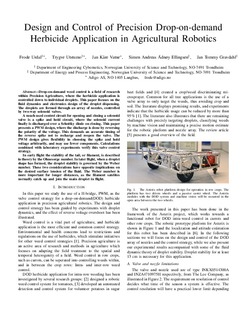| dc.contributor.author | Urdal, Frode | |
| dc.contributor.author | Utstumo, Trygve | |
| dc.contributor.author | Vatne, Jan Kåre | |
| dc.contributor.author | Ellingsen, Simen Andreas Ådnøy | |
| dc.contributor.author | Gravdahl, Jan Tommy | |
| dc.date.accessioned | 2015-01-20T10:29:28Z | |
| dc.date.accessioned | 2015-02-06T12:29:30Z | |
| dc.date.available | 2015-01-20T10:29:28Z | |
| dc.date.available | 2015-02-06T12:29:30Z | |
| dc.date.issued | 2014 | |
| dc.identifier.citation | Ukjent, Person [Eds.] Proceedings of the 13th International Conference on Control, Automation, Robotics and Vision, IEEE conference proceedings, 2014 | nb_NO |
| dc.identifier.isbn | 978-1-4799-5199-4 | |
| dc.identifier.uri | http://hdl.handle.net/11250/275556 | |
| dc.description | This is the author’s final, accepted and refereed manuscript to the article. | nb_NO |
| dc.description.abstract | Drop-on-demand weed control is a field of research
within Precision Agriculture, where the herbicide application is
controlled down to individual droplets. This paper focuses on the
fluid dynamics and electronics design of the droplet dispensing.
The droplets are formed through an array of nozzles, controlled
by two-way solenoid valves.
A much used control circuit for opening and closing a solenoid
valve is a spike and hold circuit, where the solenoid current
finally is discharged over a Schottky diode on closing. This paper
presents a PWM design, where the discharge is done by reversing
the polarity of the voltage. This demands an accurate timing of
the reverse spike not to recharge and reopen the valve. The
PWM design gives flexibility in choosing the spike and hold
voltage arbitrarily, and may use fewer components. Calculations
combined with laboratory experiments verify this valve control
strategy.
In early flight the stability of the tail, or filament, is described
in theory by the Ohnesorge number. In later flight, when a droplet
shape has formed, the droplet stability is governed by the Weber
number. These two considerations have opposite implications on
the desired surface tension of the fluid. The Weber number is
more important for longer distances, as the filament satelites
normally catch up and join the main droplet in flight. | nb_NO |
| dc.language.iso | eng | nb_NO |
| dc.publisher | IEEE conference proceedings | nb_NO |
| dc.title | Design and control of precision drop-on-demand herbicide application in agricultural robotics | nb_NO |
| dc.type | Chapter | nb_NO |
| dc.date.updated | 2015-01-20T10:29:27Z | |
| dc.source.journal | Proceedings of the 13th International Conference on Control, Automation, Robotics and Vision | nb_NO |
| dc.identifier.cristin | 1202210 | |
| dc.relation.project | Norges forskningsråd: 218701 | nb_NO |
| dc.description.localcode | Akseptert fagfellevurdert versjon/postprint. “© © 2014 IEEE. Personal use of this material is permitted. Permission from IEEE must be obtained for all other uses, in any current or future media, including reprinting/republishing this material for advertising or promotional purposes, creating new collective works, for resale or redistribution to servers or lists, or reuse of any copyrighted component of this work in other works.” | nb_NO |
